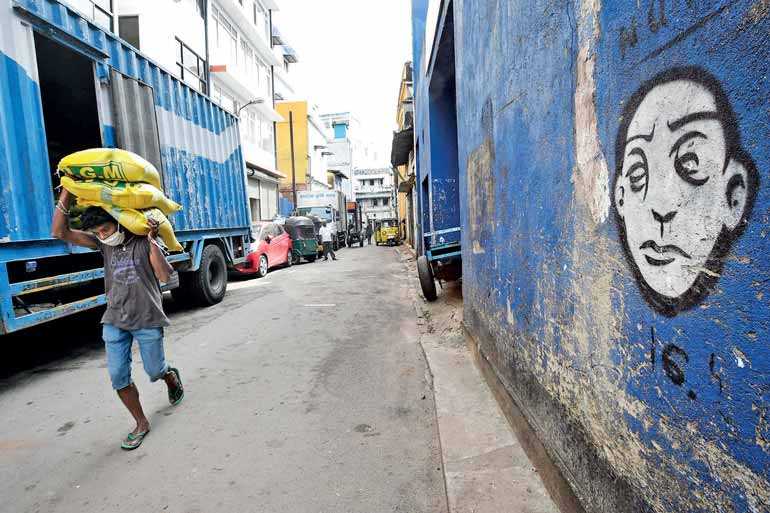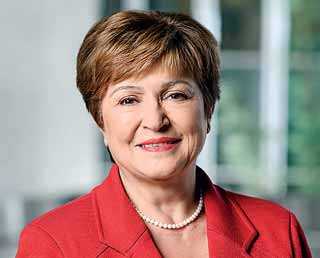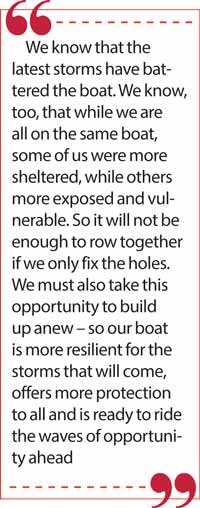Friday Jan 02, 2026
Friday Jan 02, 2026
Wednesday, 19 May 2021 00:00 - - {{hitsCtrl.values.hits}}

Around the world, it is the people who were most vulnerable before the pandemic – young people, women, low-skilled and informal workers – who were hurt the most by the crisis. And it is these groups who lose out when their governments can only deploy limited support – Pic by Shehan Gunasekara
This article is based on the remarks made by the writer who is
Managing Director of the International Monetary Fund at the Pontifical Academy of Sciences last week
By Kristalina Georgieva
Monsignor Sanchez Sorondo, President Von Braun, President Zamagni, distinguished ministers and guests: it is truly an honour and a great joy to join you today in person, as we emerge from an unprecedented crisis. With millions of people benefitting from vaccines there is a global economic recovery holding out the promise of a better future.
there is a global economic recovery holding out the promise of a better future.
But while there is hope, we also see continuing suffering, especially in countries where the human tragedy of the pandemic is far from over. Too many lives and livelihoods have been lost; vulnerable populations, young people, and women have borne the brunt of this crisis; and far too many are facing increased poverty, homelessness, and hunger.
So, how do we move forward?
In the words of the Holy Father, Pope Francis: “We emerge from a crisis either better or worse than before. It is up to us to choose.”
We choose to build forward better.
The world as it was
Let me recall the world as it was before the pandemic. When I spoke at this seminar in February of last year, I highlighted that: Economic inequality was growing. Developing economies were no longer catching up with high-income countries. Trust in institutions was falling. Social and political tensions were getting worse. And climate risks were heightening.
In other words, growth was becoming less sustainable, and too many people were falling behind. It was a world of increasing fragilities – from conflict to food insecurity to high debt burdens, especially for low-income countries.
The world as it is
Shortly after our seminar last year, the pandemic hit the world – much like a storm hitting a boat already battering rough waters.
The pandemic was the ultimate multiplier – turning fragilities into fractures, turning already high inequality into a dangerous divergence between countries and within societies, and amplifying debt difficulties in many low-income countries and some more vulnerable middle-income countries.
This is largely because developing countries had more limited capacity to fight the crisis. Advanced economies deployed the equivalent of 28% of GDP of policy support to households and firms— while the figure is around 7% for emerging markets, and just 2% in low-income countries.
We are also seeing this inequality ‘within’ countries. Around the world, it is the people who were most vulnerable before the pandemic – young people, women, low-skilled and informal workers – who were hurt the most by the crisis. And it is these groups who lose out when their governments can only deploy limited support.
If left unaddressed, unequal access to vaccines will only make this divergence worse, leaving low-income countries and vulnerable groups behind even as major economies return to some form of normalcy. The crisis has already reversed years of progress in reducing poverty and boosting development—and diverging recoveries will make it even more difficult to address these challenges.
One of the most heartbreaking examples: the impact on hunger. According to the United Nations, the number of people facing acute food insecurity last year increased by 20 million – to about 155 million. They are in need of immediate assistance.
The world as it ought to be
All of this has left the world less resilient ahead of the next big crisis: climate change. As I often say, if you didn’t like the pandemic, you will not like the climate crisis one iota.
We know that we cannot choose the world as it was before the pandemic. And we cannot afford to maintain the world as it is today.
We can only build forward better – toward the world as it ought to be: a world that is fairer, more resilient, and greener. It is a world where we find compassion in our common humanity, joy in our common home and planet, and solidarity for our common future.
All in the same boat
To take inspiration once again from the wisdom of Pope Francis: “We have realised that we are on the same boat, all of us fragile and disoriented, but at the same time important and needed, all of us called to row together, each of us in need of comforting the other.”
As we reflect on the world as it ought to be in the future, I see three ways we can draw strength from our interdependence and courage from our cooperation, recognising always that we are on the same boat, facing the same storms.
Row away from the storm
First, let us row away from the storm where we can.
Together, we can put this pandemic behind us – for all of us. Above all, this will mean cooperating to ramp up vaccine production, distribution, and deployment.
Together, we can stop and reverse the great divergence – and the inequality and suffering, food insecurity and poverty it brings to the most vulnerable among us.
That means working together to support low and middle-income countries as they work to tackle this pandemic. The spending and financing needs are high: our research shows that low-income countries have to deploy some $ 200 billion over five years just to fight the pandemic and preserve buffers – and then another $ 250 billion to invest and return to the path of catching up to higher income levels.
Meeting such needs will require comprehensive and concerted efforts — policy action by low and middle-income countries to raise domestic revenues, boost the quality of public spending, and improve the business climate; support by the international community in the form of grants, concessional and non-concessional financing, and, where needed, debt relief.
The G-20 Debt Service Suspension Initiative has provided valuable fiscal space for urgent spending to fight the pandemic in low-income countries — about $ 5.7 billion in 2020 and at least as much in 2021. The IMF has also provided debt relief to its poorest member countries through the CCRT.
For low-income countries that require deeper debt restructuring, it is now imperative to make fully operational the G-20 Common Framework, which brings together all major bilateral creditors and requires comparability of treatment by private sector creditors. Three countries have so far applied to use the Common Framework, Chad, Ethiopia, and Zambia; and the Creditor Committee for Chad has had initial productive meetings. Working very closely with our World Bank colleagues, whom I want to praise for their deep attention to debt issues, the IMF is determined to play its full part to facilitate Common Framework operations.
For middle-income countries, the IMF will continue to provide support to facilitate needed debt restructuring with private sector creditors, as it did with Argentina and Ecuador. We have upgraded our analytical tools to assess debt situations in market-access countries. And we will continue to work on improving the architecture for debt restructuring with private sector creditors — we put out a number of ideas late last year, which we are discussing with private and public counterparts.
And together, we can still move away from the worst parts of the biggest storm ahead: the climate crisis. A robust carbon price is critical to mitigating climate change. Solidarity among the largest emitters in the form of an international carbon price floor – and solidarity with the developing world through financial support – will make a huge difference in our prospects for mitigating the risks and adapting to the
consequences.
Row through the storm
Second, let us row through the storm where we must.
We cannot avoid every storm we must face. But when we row together, and learn to adapt together, we have a better chance of weathering the storm.
We see that in our remarkable ability to adapt to the COVID crisis, learning to live our lives despite unprecedented new constraints.
We see it, too, in climate action. And we know that we are more effective together. A coordinated green infrastructure push would help prepare for and adapt to future climate shocks. It could also boost global GDP in the next 15 years by 0.7% —and create millions of jobs.
We see it in the IMF’s membership coming together to support an unprecedented allocation of Special Drawing Rights of $ 650 billion, which will boost all members countries’ ability to face adverse shocks—I expect to present a formal proposal to our Executive Board next month.
We are also aware of the need to manage important risks together as the recovery picks up pace in advanced economies and policy support becomes more targeted — in particular, the potential impact of an eventual tightening of monetary policy conditions in advanced economies on vulnerable emerging market and developing economies; and the concern about a possible sharp rise in corporate bankruptcies, particularly among small and medium-sized enterprises.
Let us fortify our boat
And finally, let us fortify our boat, make it more resilient to the storms to come.
We know that the latest storms have battered the boat. We know, too, that while we are all on the same boat, some of us were more sheltered, while others more exposed and vulnerable.
So it will not be enough to row together if we only fix the holes. We must also take this opportunity to build up anew – so our boat is more resilient for the storms that will come, offers more protection to all and is ready to ride the waves of opportunity ahead.
This is at the heart of what we mean when we say: build forward better.
What will this look like? First, it means sound economic policies that create a stable foundation for growth and expand fiscal space for the future. Second, it means investing in people: expanding access to educational opportunities, building up social safety nets that can protect the health and well-being of the most vulnerable. And third, it means embracing structural transformations toward green and digital that can create new jobs and lift living standards around the world.
Conclusion
Let me conclude with this. When I think about the future, I cannot help but think of my young granddaughter. Will the world she live in a world that is better after this crisis – or worse?
For her, for the next generation, and for all of us, the choice is clear: we choose to build forward better.
We can do it – together.